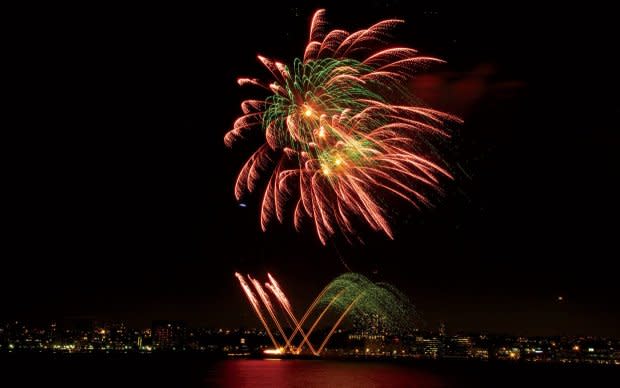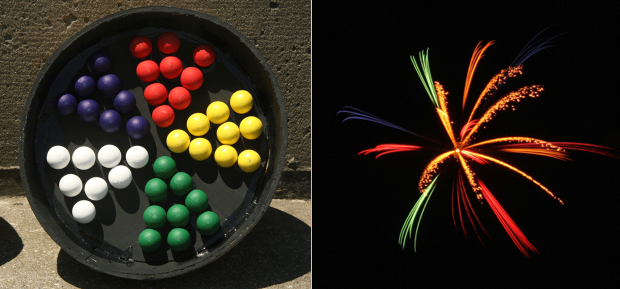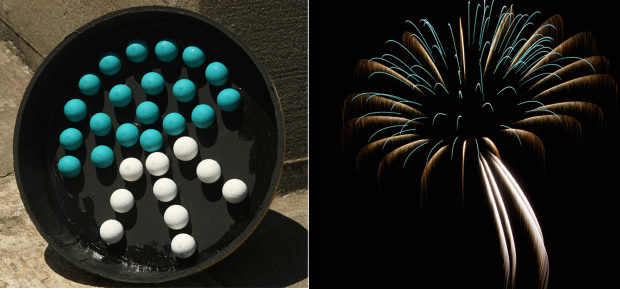We've Got the 411 on Fireworks—Including How They Get Their Shapes, Which Color Is the Hardest To Make and More

Jim Souza
Fireworks come in all sorts of colors that cause delight and awe as they light up the sky. The most famous fireworks displays in the country usually occur on New Year's Eve and the 4th of July, and these displays can cost cities thousands of dollars to orchestrate. July 4th fireworks occur across the U.S. as Americans trot out their best red, white and blue fireworks for their Fourth of July celebrations. But what exactly goes into the world's beloved fireworks? How do fireworks get their colors and is it harder to make some hues than others? We asked an expert a few questions to get those answers for you.
Related: Best July 4th Fireworks in Every State, Where To Watch
What makes fireworks colorful?
The color in fireworks come from metal salts, which are made up of metal and non-metal atoms that create pure, intense colors when burned (they burn via a range of other chemical compounds and elements added to the aerial shells before the explosion). Some of the most common metal salts used to create brilliantly colored fireworks include copper salts for blue fireworks, calcium salts for orange fireworks and strontium salts for red fireworks.
Related: Best Places to See Fourth of July Fireworks in Every State
Is it harder to make fireworks in certain colors?
View the original article to see embedded media.
“It’s harder to make blue fireworks. It’s all about balancing heat and the chemical compositions,” says Jim Souza, whose Pyro Spectaculars runs the Macy’s July 4 show, the nation’s largest.
Macy's July 4, 2023 show
According to their site:
Kicking off on Tuesday, July 4 at roughly 9:25 p.m., the 25-minute event will feature the most “dynamic collection of animated shells ever launched” during Macy’s fireworks show, with 60,000 shells featuring multiple effects spanning a mile across the East River and about 1,000 feet above the city.
Produced by Macy’s with Pyro Spectaculars by Souza, the dazzling display will feature new effects, like a mile-wide waving flag, a sunflower ring, red stop sign-shaped effects, and “Ghost” pyro that turn from one color to another.
The show will be synchronized to a musical score curated by Ray Chew featuring American classics like “The Star Bangled Banner,” “America the Beautiful,” “Lift Every Voice and Sing,” and “Ain’t No Mountain High Enough.”
During the signature moment, thousands of golden-colored shells will create an iconic cascade effect, set to “The Best” by Tina Turner.
Each year on the 4th of July, Souza’s company stages about 400 shows.
Related: Ways to Comfort Your Dog During Fireworks
How do they make fireworks into different shapes?
Ever wonder how they make fireworks into shapes? Basic fireworks are spheres, Souza says. Cut one in half and you’ll find chemical “marbles” carefully arranged as, say, a smiley face or a star. When the fuse hits the explosive powder at the center of the marbles, boom! They shoot into the sky but maintain their original formation.
Check it out:

Jim Souza

Jim Souza
How much does it cost to set off one firework?
"It should be anywhere from fifty dollars to five hundred dollars," Souza says. "It depends on the size, the complication of the design." In previous years, the projected cost for the Macy's July 4 show has been in the seven figures.
No surprise, considering the effort required to pull off the country's most iconic firework display. "Right after the shell [goes off] in the grand finale, we start planning for the following year," Souza says. "We’re immediately looking at the effects that worked, things we wanted to improve, or new ideas come from that. We’re off traveling the world trying to find new effects."
Up next, discover the 75 Best Inspirational 4th of July Quotes.
ALSO READ:
